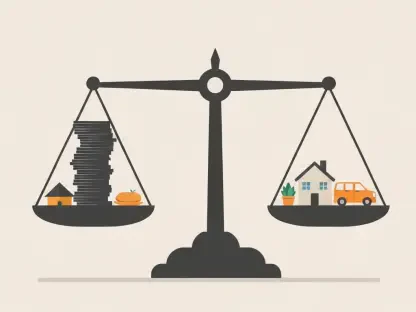In an era where global debt has skyrocketed beyond $100 trillion, the debt recovery sector stands as a compelling arena for investors seeking to turn financial distress into opportunity, especially as sovereign and corporate borrowing continues to climb. OECD nations are projected to issue a staggering $17 trillion in sovereign debt this year alone. Meanwhile, household and small business struggles are evident, as U.S. credit card delinquency rates reach a decade-high of 1.69% and nearly 50,000 UK businesses face critical financial distress, marking a 21.4% year-over-year surge. These alarming statistics underscore a pressing need for effective debt recovery solutions, positioning the sector as a structural, long-term prospect rather than a passing trend. This article delves into the dynamic landscape of debt recovery, examining how economic challenges and technological advancements create fertile ground for profit across traditional financial services, credit counseling platforms, and fintech innovations.
Adapting to Financial Distress through Traditional Services
The role of traditional financial institutions in addressing debt distress has evolved significantly, with banks and alternative lenders stepping in as vital lifelines for struggling borrowers. Products such as debt consolidation loans and refinancing packages are increasingly tailored to high-risk clients, reflecting a shift toward accommodating those with limited options. A notable example is KeyCorp’s strategic partnership to offload high-risk credit card portfolios to specialized asset managers, allowing banks to minimize exposure while maintaining client relationships. This trend highlights a broader movement where distressed debt is managed through automated underwriting tools, reducing risk for lenders. For investors, targeting firms that enable these transactions offers a gateway to capitalize on the rising demand for “second-chance” credit products. The potential for returns is substantial in markets where conventional banking has retreated, creating a vacuum for alternative solutions to fill.
However, navigating this space is not without challenges, as high default rates among subprime borrowers pose a persistent threat to profitability. The risk of loans going unpaid can quickly erode margins, making accurate risk assessment a cornerstone of success. Investors must focus on companies with robust credit analytics capable of predicting and mitigating defaults. Additionally, the economic environment, characterized by high interest rates and shorter-term debt obligations, adds layers of complexity to lending strategies. Monitoring broader market indicators, such as consumer spending patterns and employment data, can provide critical insights into potential shifts in borrower behavior. By aligning with financial service providers that prioritize precision in risk pricing and maintain agility in adapting to economic conditions, investors can position themselves to reap rewards while managing the inherent uncertainties of distressed debt markets.
Harnessing Credit Counseling for Stable Gains
Credit counseling platforms, spanning both nonprofit and for-profit entities, are carving out a significant niche by merging financial education with direct creditor negotiations. These platforms offer debt management plans that have proven effective, with participants reducing revolving debt by an average of $3,637 within 18 months, often benefiting from interest rate reductions of 15 to 20%. This dual focus on empowerment through knowledge and practical debt relief fosters high customer retention, translating into recurring revenue streams for providers. The growing demand for such services, driven by escalating household financial stress, positions credit counseling as a reliable avenue for investors seeking consistent returns. By supporting platforms that demonstrate measurable impact, there’s an opportunity to tap into a sector that addresses a critical societal need while delivering financial upside.
Yet, the path to profitability in credit counseling is not without hurdles, as regulatory oversight intensifies around issues like transparency and so-called “junk fees.” Bodies like the Consumer Financial Protection Bureau (CFPB) are cracking down on practices perceived as exploitative, creating compliance challenges for operators. Investors must prioritize platforms with a track record of reducing delinquencies and improving client credit scores, as these outcomes often correlate with regulatory favor and long-term viability. Additionally, the competitive landscape requires differentiation through technology, such as AI-driven tools that personalize repayment plans. By focusing on entities that balance innovation with adherence to strict guidelines, investors can mitigate risks while benefiting from a sector that offers both stability and the potential for meaningful social impact in helping individuals regain financial control.
Revolutionizing Recovery with Fintech Solutions
Fintech innovations are at the forefront of transforming debt recovery, leveraging cutting-edge technologies like AI-driven analytics and blockchain-based smart contracts to deliver hyper-personalized solutions. Tools such as AI chatbots provide real-time repayment guidance, while blockchain enables automated debt restructuring, streamlining processes that were once cumbersome. Major players like JPMorgan are investing heavily in generative AI to enhance customer engagement, signaling the sector’s vast potential. With market growth projected at 15% annually through 2027, fintech offers a dynamic space for investors to engage with forward-thinking solutions that address modern debt challenges. The ability to adapt quickly to individual borrower needs positions these technologies as game-changers in a landscape hungry for efficiency and customization.
Despite the promise of high growth, fintech investments in debt recovery come with notable risks, including cybersecurity vulnerabilities and data privacy concerns that could undermine consumer trust. Evolving regulations also pose a challenge, as authorities may impose restrictions on algorithmic decision-making to protect borrowers. Investors should seek out fintech firms with robust compliance frameworks and a commitment to safeguarding sensitive information. Furthermore, the rapid pace of technological change demands that companies stay ahead of the curve, continuously updating their offerings to remain competitive. By aligning with fintechs that prioritize both innovation and risk management, investors can harness the transformative power of technology to achieve substantial returns while navigating the complexities of a sector still defining its boundaries in the debt recovery ecosystem.
Managing Risks for Sustainable Profits
The debt recovery sector, while ripe with opportunity, demands a cautious approach to risk management to ensure sustainable gains. Regulatory scrutiny from entities like the CFPB remains a significant concern, as crackdowns on predatory practices can impact profitability for companies that fail to comply. High default rates, particularly among nonprime borrowers, further complicate the landscape, potentially leading to substantial losses if not properly anticipated. Investors must emphasize the importance of accurate risk pricing, ensuring that the potential for defaults is factored into investment decisions. Staying informed about legislative changes and maintaining a proactive stance on compliance can help mitigate the impact of regulatory challenges on portfolio performance.
Beyond regulatory and default risks, broader economic indicators play a critical role in shaping the debt recovery market’s trajectory. Metrics such as delinquency rates and interest coverage ratios offer valuable insights into potential downturns, with spikes in 90+ day delinquencies for auto loans often signaling wider sector stress. Investors should adopt a vigilant approach, regularly analyzing these indicators to anticipate shifts in borrower behavior or market conditions. Partnering with firms that employ sophisticated credit analytics can enhance the ability to predict and respond to such trends effectively. By maintaining a balanced perspective that weighs both the opportunities and the pitfalls, investors can build resilience into their strategies, ensuring that returns are not only achieved but also preserved over the long term in a volatile economic environment.
Building a Diversified Investment Approach
Diversification stands as a cornerstone strategy for investors aiming to thrive in the debt recovery sector, offering a way to balance stability with growth potential across varied subsectors. Spreading investments across traditional financial services, credit counseling platforms, and fintech innovations allows for exposure to different risk profiles and return opportunities. Traditional lenders provide a foundation of reliability, while credit counseling offers steady, recurring gains, and fintech introduces high-growth prospects. This multi-pronged approach helps cushion against sector-specific downturns, as challenges in one area may be offset by strengths in another. Crafting a portfolio that spans these diverse segments can maximize upside while minimizing the impact of isolated setbacks in the complex debt recovery landscape.
Equally important is the emphasis on strategic partnerships within the debt ecosystem, as collaboration with creditors, credit bureaus, and regulators can significantly enhance outcomes. Companies with strong alliances are better equipped to navigate operational and compliance challenges, ensuring smoother execution of debt recovery initiatives. Investors should seek out entities that demonstrate a knack for building and maintaining such relationships, as these connections often translate into competitive advantages. By adopting a diversified strategy underpinned by a focus on partnership-driven firms, the potential for success is amplified, allowing for a more robust engagement with a sector defined by both its promise and its intricacies, ultimately paving the way for sustained profitability.
Charting the Path Forward with Strategic Insights
Reflecting on the debt recovery landscape, it becomes clear that the sector offers a unique blend of challenges and opportunities for those willing to engage with its nuances. The staggering scale of global debt, coupled with rising delinquency rates, underscores the urgent need for innovative approaches, from traditional lending adaptations to tech-driven solutions. Investors who navigate this space successfully often do so by embracing diversification, ensuring their portfolios span the spectrum of financial services, counseling platforms, and fintech advancements. Looking ahead, the focus should shift toward actionable steps, such as closely monitoring emerging regulatory frameworks and economic indicators to stay ahead of potential disruptions. Prioritizing investments in companies with strong risk management practices and technological edge will be crucial for sustaining gains. As the debt recovery sector continues to evolve, aligning strategies with platforms that empower financial recovery can yield not only profit but also a meaningful contribution to addressing systemic economic challenges.









